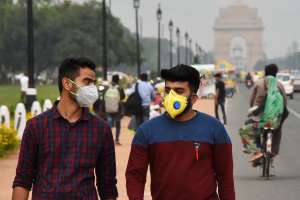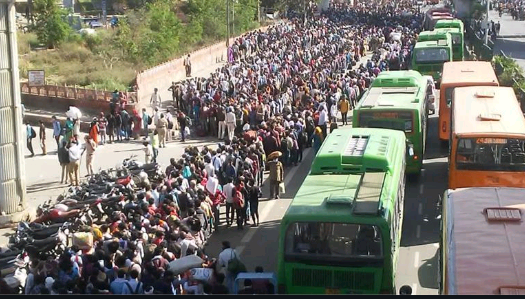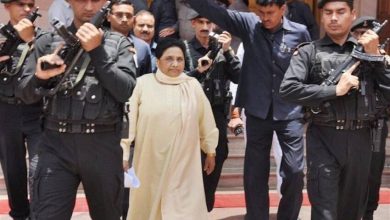Is India heading towards herd immunity?
(कृपया हिंदी अनुवाद लेख के अंत में नीचे पढ़ें)
 Nihar Satpathy, author and political analyst
Nihar Satpathy, author and political analyst
With the announcement of the third phase of lockdown extending it further for a period of two weeks from May 4 India has given a round of fillip to its pandemic management. When the lockdown was initially conceived on March 24 for nation-wide implementation at the first glance cynics began to express doubts where it would lead to. Could the spread of the pandemic be halted by just locking down people indoors? This was a thousand dollar question.
As India enters the third phase of the lock down a clear pattern emerges in the government’s approach to the pandemic. The official number of the victims of Covid 19 now stands at around 37000, which figure also includes recoveries from the infection. This is a minuscule figure in a country with a massive population of 1.3 billion. It dwarfs on the face of the comparable data from some of the world’s most advanced countries, such as the USA where the number of infected people now stands at 1.1 million even when it has a population of almost one fourth of India’s size. It certainly vindicates the efficacy of the path followed by India so far in tackling the pandemic.
But as the number of confirmed cases of Covid 19 have increased from 360 on March 24, when the first stage of lock down was implemented, to almost 37000 now, the question remains where is it heading to? Although the doubling rate has declined from three days to 11 days during the same period India’s future roadmap to a state of normalcy in this regard raises certain questions. It goes without saying that the certain favourable factors such as the low share of elderly population and climatic conditions have contributed significantly to flattening of the curve in addition to some of the noteworthy steps taken by the Indian government in managing the pandemic, the lockdown being the foremost among them.
New Normal
But the fact remains that the country cannot remain in a state of lockdown for an indefinite period. In this context the Infosis founder N.R.Narayana Murthy has significantly said in a statement that the country must accept the coronavirus as the new normal. This appears to be inevitable.
In this perspective a few of the collateral measures adopted of late in India points to an unusual angle of the government’s approach to the issue. It has interestingly been observed that mass movement of certain segments of population has been sponsored by the central as well as some of the state governments over the period, albeit indirectly without being above board. Way back in the last week of March while thousands of migrant labourers in Delhi were transported in buses of the Delhi government to its borders, at the same time news was afloat that the chief minister of Uttar Pradesh was also readying connecting buses to bring them back inside Uttar Pradesh, which was however abandoned later as concerns were raised over such a move.
But now it has become official. The latest developments in this respect show that several of the state governments have been arranging quite a considerable number of bus services for bringing back not only the migrant labourers but also students and even the general diaspora. The Indian Railway has also pressed into service several trains for such mass movement of people even as the lock down continues. Such a movement has now been officially provided for in the guidelines of the union home ministry in the third phase of the lock down. As yet another step, the movement of the public outside their homes within the cities has also been eased, though in a regulated manner.
Please also read : https://mediaswaraj.com/covid-19-lessons-for-india-from-italy/
Escape route
It therefore raises a question whether India has chosen herd immunity as one of its escape routes from the crisis. The absolute level of Covid 19 infections in the country is well below the minimum level required for the herd immunity in order to succeed. As per epidemiologists a minimum of 60 % of the population needs to be infected in natural course so that mass immunity can be achieved. A majority of the Covid 19 infections being self-limiting and non-fatal in nature this option does not remain untouchable by the health managers. No nation can of course openly announce it as a state policy for fear of a backlash. However some of the European nations such as Sweden are found to be visibly heading in this direction with appreciable outcome.

In the current situation this option for herd immunity was first suggested by the United Kingdom’s chief science adviser Sir Patrick Vallance which sparked off a debate. The apprehensions in this regard are having a strong foundation which cannot be ignored. Given that the absolute number of mortality due to Covid 19 is very high, even though its ratio is low compared with the other epidemics the world has faced, this route of herd immunity appears to be a risky gamble.
It would be interesting to know if such a route is open to a country like India with massiveness of its population which is not easy to micromanage. So far the government of India has managed it in an exemplary manner prompting many accolades from the world community. So far so good, but what is the next move? It is not that the policy makers at the health ministry are not seized of the matter, and the finer nuances of some of its latest actions indicate that it is not averse to go for such a kind mass immunity.
क्या भारत धीरे-धीरे हर्ड इम्युनिटी प्रबंधन की ओर बढ़ रहा है?
नीहार शतपथी, लेखक और राजनीतिक विश्लेषक
लॉकडाउन को दो हफ़्ते के लिए और बढ़ाकर 4 मई से इसके तीसरे चरण की घोषणा के साथ, भारत ने अपने महामारी प्रबंधन को आगे बढ़ाया है। जब पूरे देश में लागू के लिए 24 मार्च को पहले लॉकडाउन का विचार लाया गया था, तो आलोचकों को इसकी सफ़लता पर संदेह था। क्या लोगों को सिर्फ़ घर के अंदर बंद करके महामारी को फैलने से रोका जा सकता है? यह एक बड़ा सवाल था।
भारत के लॉकडाउन के तीसरे चरण में प्रवेश करने के साथ ही महामारी के लिए सरकार के नज़रिए में एक पैटर्न साफ तौर पर उभरता दिखाई देता है। Covid 19 के पीड़ितों की आधिकारिक संख्या अब लगभग 37000 हो गई है, इसमें ठीक होने वालों की संख्या भी शामिल है। यह 1.3 बिलियन की बड़ी आबादी वाले देश के लिए एक छोटा सा आंकड़ा है। यह दुनिया के कुछ सबसे उन्नत देशों के आंकड़ों के सामने बहुत कम है, जैसे कि अमरीका जहां संक्रमित लोगों की संख्या 1.1 मिलियन है, जबकि उनकी आबादी भारत से लगभग एक चौथाई है। यह निश्चित रूप से महामारी से निपटने में भारत की कोशिशों के प्रभाव को दिखाता है।
लेकिन जब पहली बार 24 मार्च को लॉकडाउन किया गया था , तब से Covid 19 के पुष्ट मामलों की संख्या 360 से बढ़ कर लगभग 37000 हो गई है, तो सवाल यह है कि क्या हम सही दिशा में जा रहे हैं ? अब केस तीन दिनों की बजाय 11 दिनों में दोगुने हो रहे हैं , फिर भी इस संबंध में भारत के भविष्य के रोडमैप में स्थिति के सामान्य होने के बारे में कुछ सवाल उठते हैं। कहने की आवश्यकता नहीं है कि महामारी के प्रबंधन में भारत सरकार द्वारा उठाए गए कुछ उल्लेखनीय कदमों के साथ -साथ कम बुजुर्ग आबादी और जलवायु परिस्थितियों जैसे कुछ कारणों ने भी ग्राफ की वक्र रेखा को सीधा करने में बहुत योगदान दिया है।
नया नॉर्मल
लेकिन सच्चाई यह है कि देश अनिश्चित काल के लिए लॉकडाउन की स्थिति में नहीं रह सकता। इस संदर्भ में इंफ़ोसिस के संस्थापक एन.आर.नारायण मूर्ति ने बहुत महत्व की बात कही है कि देश को कोरोना वायरस को नया नॉर्मल मानना होगा। लगता है कि ऐसा ही होने वाला है।
पिछले कुछ दिनों में इस मुद्दे के लिए अपनाए गए कुछ अतिरिक्त उपायों ने सरकार के रवैये के एक असामान्य ऐंगल की ओर इशारा किया। यह दिलचस्प रूप से देखा गया कि इस दौरान आबादी के कुछ हिस्सों की बड़े पैमाने पर आवाजाही को केंद्र और साथ ही कुछ राज्य सरकारों द्वारा प्रायोजित किया गया, हालांकि अप्रत्यक्ष रूप से। मार्च के आखिरी हफ्ते में जब दिल्ली के हजारों प्रवासी मजदूरों को दिल्ली सरकार की बसों से सीमा पर ले जाया गया था, उसी समय खबर आई थी कि उत्तर प्रदेश के मुख्यमंत्री भी उन्हें सीमा से लाने के लिए बसें भेजने की तैयारी में थे। हालांकि इस तरह की हरकत पर चिंता जताए जाने के बाद इसे छोड़ दिया गया था।
लेकिन अब इसे आधिकारिक तौर पर मान लिया गया है। इस संबंध में नए घटनाक्रम बताते हैं कि कई राज्य सरकारें न केवल प्रवासी मज़दूरों, बल्कि छात्रों और यहां तक कि सामान्य नागरिकों को भी वापस लाने के लिए बड़ी संख्या में बस सेवाओं की व्यवस्था कर रही हैं। लॉक डाउन जारी है, पर भारतीय रेलवे ने भी ऐसे लोगों के आने-जाने के लिए कई ट्रेनों की सेवा शुरू की है। केंद्रीय गृह मंत्रालय के दिशा-निर्देशों में लॉक डाउन के तीसरे चरण में इस तरह की आवाजाही को मंजूरी दे दी गई है। एक और बात, कुछ शर्तों के साथ, शहरों में लोगों को अपने घरों के आस-पास घूमने की भी अनुमति मिल गई है।
बचाव का रास्ता
इससे एक सवाल उठता है कि क्या भारत ने सामूहिक प्रतिरोधक क्षमता (हर्ड इम्युनिटी) विकसित करने को संकट से बचने का एक तरीका मान लिया है। देश में Covid 19 संक्रमण का स्तर इतना ज़्यादा नहीं है कि सामूहिक प्रतिरक्षा सफल हो सके। महामारी वैज्ञानिकों के अनुसार, जब कम से कम 60% आबादी प्राकृतिक तरीके से संक्रमित हो, तभी सामूहिक प्रतिरक्षा सफ़ल होती है। Covid 19 के अधिकतर संक्रमण अपने आप में सीमित और प्रकृति में गैर-घातक होने के कारण यह विकल्प स्वास्थ्य प्रबंधकों द्वारा अछूता नहीं है। अक्सर तीव्र प्रतिक्रिया के डर से कोई भी राष्ट्र इसे राज्य की नीति के रूप में घोषित नहीं करता। हालाँकि कुछ यूरोपीय देशों जैसे स्वीडन में इसके सराहनीय परिणाम देखे जा सकते हैं।
वर्तमान स्थिति में सामूहिक प्रतिरक्षा का यह विकल्प पहली बार यूके के मुख्य विज्ञान सलाहकार सर पैट्रिक वालेंस द्वारा सुझाया गया था, जिससे एक बहस छिड़ गई थी। इस बारे में कुछ ऐसे संदेह हैं, जिन्हें नज़रअंदाज़ नहीं किया जा सकता। भले ही इसका अनुपात दुनिया की अन्य महामारियों की तुलना में कम है, तो भी Covid 19 से मरने वालों की संख्या काफ़ी है, इसलिए सामूहिक प्रतिरक्षा की राह जुए के समान जोखिम भरी है।
यह जानना दिलचस्प होगा कि क्या भारत जैसे देश में यह सही विकल्प होगा , जहां आबादी इतनी ज़्यादा है कि उसे संभालना आसान नहीं है। अब तक भारत सरकार ने इसे बहुत अच्छे ढंग से संभाला है और अपने प्रयासों के लिए विश्व समुदाय से प्रशंसा प्राप्त की है। अब तक तो सब अच्छा है, लेकिन आगे क्या होगा ? ऐसा नहीं है कि स्वास्थ्य मंत्रालय में नीति निर्माताओं ने इस मामले पर ध्यान नहीं दिया है। उनके कुछ नए कार्यों को बारीकी से देखा जाए, तो संकेत मिलता है कि इस तरह से बड़े पैमाने पर प्रतिरक्षा का परिणाम उल्टा नहीं पड़ेगा।







A good article with in depth analysis.
A very sound and lucid analysis of both national and international happenings on the outbreak of COVID 19. Intellectuals representing various fields opine their own views. The truth of the future is always debatable, controversial and ambiguous. Here the writer has presented the truth of the present scenario in India without any turn to any dogma of science. Many many thanks to Shri Satapathy for his scientific approach of analysis.
Nicely explained with all necessary points
Herd immunity? Indeed a risky proposal with uncertain results and sacrifice of few for the benifit of society. Better to comment now because hindsight is always 20-20.